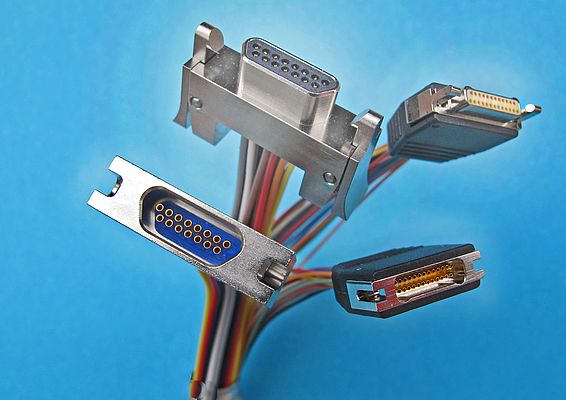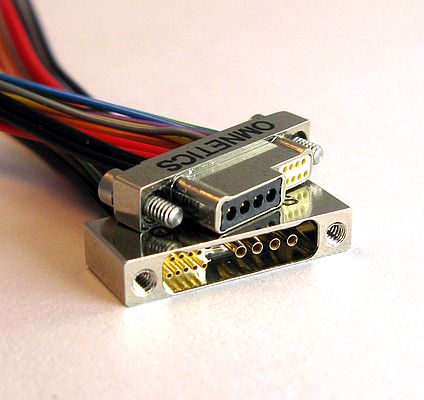To identify trends and ensure deployment of the latest technologies, customers often ask which connectors are currently proving popular. At Omnetics Connector Corporation, recent exponential sales growth has been witnessed in the Metal Nano-D connector series, which was developed in line with Military Standard specification number 32139 for small yet rugged high-density interconnects. Notably, Nano-D connectors are set on a pinto-pin spacing of 0.635mm (in contrast to the older Micro-D connector, which is twice the size).
In generic terms, today’s connector industry is subject to six different areas of growth, which are referred to using the acronym ‘FESTER’ (Faster, EMI-shielded, Smaller, Tough, Easy to lock, and Rapid design and delivery). Matching all of these attributes is the Nano-D, a connector that can also be quickly modified to meet customer or application-specific design criteria.
Among the applications driving demand for Nano-D is body-worn electronics, which are now being used by a wide range of industries from mountain climbers to military ground troops. Electronics attached to soldiers’ helmets and vests help military troops retain constant contact with battlefield control, as well as receive mapping, imaging and other critical information.
A further application fuelling the trend for Nano-D connectors is found within UAVs, typically as a result of the demand for rugged yet lightweight performance. For the same reasons, manufacturers of ground robotics are also ramping up their adoption of Nano-D. Notably, the connector is still sufficiently large to offer up to 3 amps of current per pin where required. Simultaneously, the connector can accommodate high-speed differential signal processing data that includes USB signals up to 5Gb.
Looking ahead
Among the current important focus areas at Omnetics is rugged miniaturisation of highspeed digital signal processing. This work has been prioritised as there is soon likely to be an evolution of highly portable Ethernet systems, SBCs (signal board computers), portable surveillance systems that capture high volumes of data, and emerging chip technologies focused on processing that data at everfaster rates.
New products available today include HDMI and USB-C connectors, which are smaller and more rugged than existing standard counterparts. Frequently, requirements arise for a standard USB format connector at one end of a copper cable with a high-density connector at the other. With this in mind, Omnetics is working attentively with several cable designers to establish a new level of innovation and performance that goes far beyond today’s commercial products.
With good reason, design engineers are often keen to learn about the special characteristics of hybrid connectors and cable sets, which reduce the system’s number of cables, require less panel space where the connector meets a module, and ultimately save the customer money. At Omnetics, hybrid connectors are focused on rapid custom configurations that integrate various signal technologies into a single connector and cable.
Although Omnetics offers a certain number of standard hybrid connector sets, today’s evershorter design-to-product phase means that the company works more with designers looking to fulfil specific criteria. For instance, a common demand is the need to combine power, signal and speed in the same connector.
Tasked with such a requirement, Omnetics can work closely with the design engineer to determine the quantity of each signal type and precisely how much power is needed to optimise the performance and functionality of the connector for the specific application. The process typically starts with a standard micro- or nanosized connector design before the insulator and pin/socket sets are modified accordingly. Solid Modelling software is used to accelerate this phase of the project and, once complete, the design is sent directly to the customer. Following discussions, rapid prototype tooling is actioned to set the insulator with the correct hole sizes so that the pin can be matched to the selected socket sets.
It is highly important at all stages of such projects to assess the key technical considerations. For example, when the requirements of speed and power are combined, cable design becomes a major element of scrutiny. Highspeed differential signal pairs must be twisted in a wrapping process that speeds performance, before drain wires are added. The three-wire set is then shielded with metal foil to prevent noise interference to and from adjacent wiring sets. Power signals are also known to create hum, noise or jitter in the cable and connector. With this in mind, hybrid elements are isolated or set apart from the lower voltage signal wires.
Compact size, light weight, rugged performance, and higher speed signal transmission are typically among the special characteristics of Omnetics hybrid connectors. As a result, interest in hybrid connectors has spiked, especially as they can be prototyped specifically to customer requirements. No longer do engineers have to compromise size or function by using off-the-shelf connectors.
Chip technology
In the future, chip technology could well prove to be the driving force behind cable and connector development. It is noticeable that CMOS (Complementary Metal-Oxide Semiconductor) technology has driven higher speeds, and now more GaAs (gallium arsenide) to GaN (gallium nitride) is being seen in the market, most importantly at lower voltages and lower current flow levels. As speed increases and voltage requirements decrease, ever-smaller cable wire and connectors will be needed.
Of course, miniaturisation in interconnections and hybrid connectors brings about certain challenges. When using hybrid cables and connectors, the PCB must be designed so that it can adapt to receiving dissimilar signals in close proximity. Traditionally, power supply signals come into the back end of a PCB, while high-speed signals arrive at the front. Although design engineers want the advantages of combined signal and power, they must also help in the ‘signal launch’ to and from PCBs. In addition, a high-speed differential signal arrives on a pair of wires, so both signals must be patterned with identical signal length to the processor. Any difference in signal arrival time causes signal ‘skew’, leading to pixilation or no signal at all.
Miniaturisation trends
Hybrid connector miniaturisation has increased demand for small but sturdy latching or locking hardware from the connector to the mating socket. Clearly, finding room and avoiding tools is important, which is why new latching connectors from Omnetics have been developed and tested to exceed the same shock and vibration standards of older connectors that require screws.
All of this begs the question: when will miniaturisation reach its limits? To arrive at the answer, it should be remembered that signal integrity management has always been the key element in connector technology. Omnetics has tested the number of mating and de-mating cycles a connector can endure – a key feature for potential failure. Connectors manufactured by Omnetics exhibit over 10,000 mating and de-mating cycles without failure, while some competing miniaturised connector designs fail at a much lower number.
Ultimately, physical latching and mating will continue to challenge the industry as connectors get smaller. Additionally, cable strength and reliability – as internal wires and cable diameter reduce in size – can limit some designs. In the long run, proximity-based inductive coupling may become more and more commonplace, in a similar way that many mobile phones can now be charged by placing them close to a power source.

























